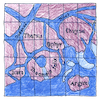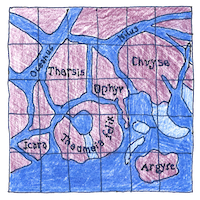Giovanni Schiaparelli
astronomy

|
Canals on Mars
The Italian astronomer Giovanni Virinio Schiaparelli, director of the observatory at Brera, charted the surface of Mars and described it as being criss-crossed with channels. Unfortunately, the Italian word for channels is canali, mistranslated canals, and everybody knows canals are built to move water to support agriculture to feed people in cities. From a long distance, lines seen while straining at Mars through wavering skies and murky lenses convince the eye there’s a pattern and a purpose. It is easier to believe than to doubt. Even the willing suspension of disbelief is an easy trick for creatures who fall in love who survive hurricanes and pogroms who have their own prejudices and self-interests and for whom thoughts of little red Martians is entertaining or comforting. Normally, the mind sees only what it wants. Belief in the unsupportable is the definition of belief. It is banal to point out that many are sadly mistaken, even people with good intentions. When the unpredictable cannot be avoided the shock can damage the mind. After the trauma subsides scar tissue can diminish the flexibility that helps the mind work. The work of the mind is to make the subtle shifts in color and shading cohere into pleasures or threats. Canals on Mars are far enough away not to threaten but only tease. Maybe this explains everything.



Giovanni Schiaparelli not only identified the channels but he named the “seas” and “continents” of Mars, and in 1861 he discovered the asteroid 69 Hesperia.
I confess that I see thin white lines connecting the stars of the Big Dipper when I stare at it in the night sky. It may be surprising, if we should ever see the world through the eyes and brain of another species, to discover how much we imagine our world to suit ourselves. At any rate, we should forgive Schiaparelli his canali and imagine his joy in discovering another world with a pattern and a purpose. Maybe we should even forgive the people who mistranslated Schiaparelli’s Italian and those who took the unintended distinction to justify their belief in life on Mars.
See also in The book of science:
Readings in wikipedia: